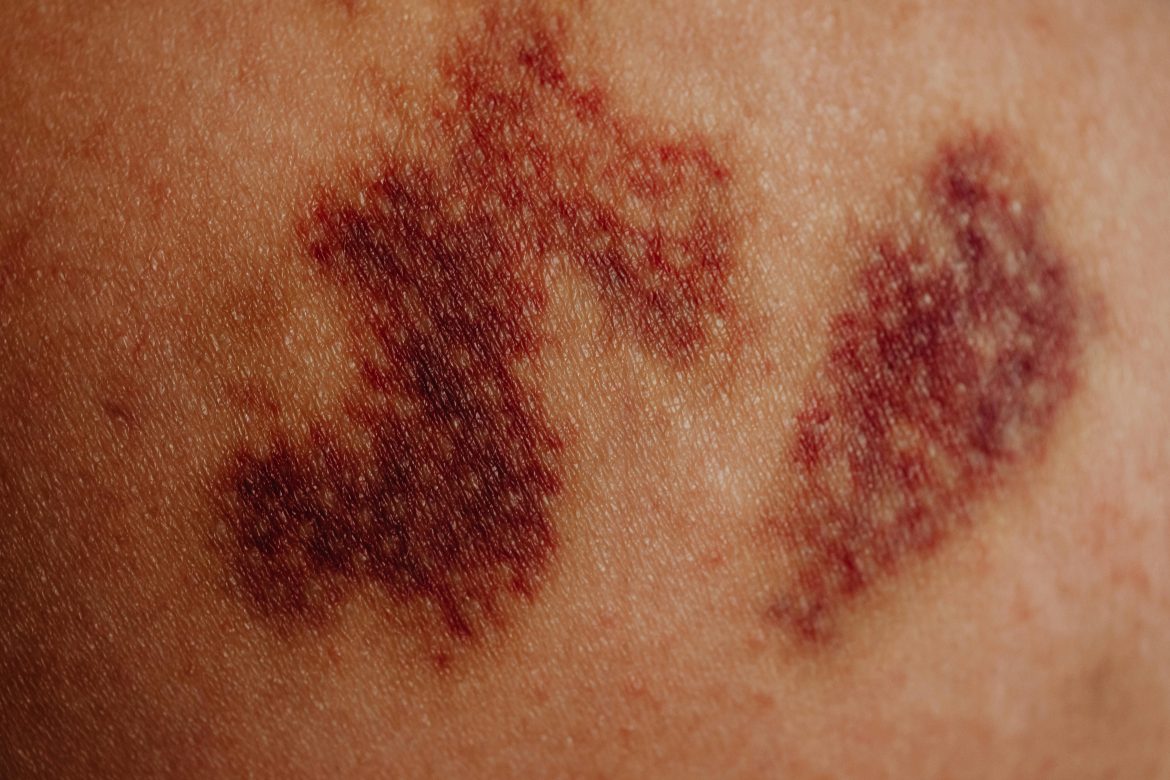Blood pooling, also known as hematoma or ecchymosis, occurs when blood collects outside of blood vessels, either beneath the skin or within body tissues.
Appearing as a red and blue ombre bruise, this can happen due to various reasons, from minor injuries to more complex medical conditions. Understanding why blood pooling happens and knowing how to manage it can help alleviate discomfort and promote better healing.
What Is blood pooling?
Blood pooling refers to the accumulation of blood outside of its normal circulatory pathways. This can occur in two primary forms:
Under the skin (Hematoma or bruise): This happens when blood vessels rupture due to trauma or injury, leading to blood leaking into the surrounding tissue. The result is a bruise like appearance, which often changes colour as it heals—from red to purple, then yellow-green.
Within the skin (Ecchymosis): This is similar to bruising but can occur without a significant impact or trauma. It involves larger areas of blood leakage and is sometimes associated with blood clotting disorders or medication side effects.
Common causes of blood pooling
- Trauma or injury: Direct impact, falls, or accidents can cause blood vessels to break and lead to bruising.
- Medical conditions: Disorders like hemophilia or blood vessel abnormalities can predispose individuals to spontaneous bleeding.
- Medications: Certain medications, such as blood thinners, can increase the likelihood of bruising.
- Ageing: As skin and blood vessels age, they become more fragile and susceptible to bruising.
- Underlying health conditions: Conditions affecting blood clotting, such as liver disease or certain cancers, can also lead to blood pooling.
Symptoms to watch for
- Discolouration: Initially red or purple, bruises may turn blue, green, or yellow as they heal.
- Swelling: The area may swell due to accumulated blood and fluid.
- Pain or tenderness: Bruised areas often feel sore or tender to touch.
- Warmth: The affected area may feel warm or hot due to inflammation.
When to seek medical attention
While minor bruising usually resolves on its own, there are cases where medical attention is necessary:
- Severe pain or swelling: Intense discomfort or significant swelling could indicate a more serious injury.
- Unexplained bruising: Frequent bruising without apparent cause may signal a blood clotting disorder or other health issue.
- Signs of infection: Redness, increasing warmth, and pus could indicate an infection in the area of the bruise.
- Large hematomas: Especially if associated with severe trauma, large blood collections may require medical evaluation.
Treatment and management
Most minor bruises or hematomas do not require professional medical treatment and will heal on their own. However, there are several methods to help alleviate discomfort and speed up recovery:
- Rest and elevation: Keep the affected area elevated to reduce swelling and promote drainage.
- Ice application: Apply ice or a cold compress to the area for the first 24-48 hours to minimise swelling and numb pain. Be sure to use a cloth or towel to protect your skin.
- Compression: Gently wrap the area with an elastic bandage to help reduce swelling. Ensure it’s not too tight, as this can impede circulation.
- Pain relief: Over-the-counter pain relievers like acetaminophen or ibuprofen can help with discomfort. Avoid aspirin, as it can increase bleeding.
- Heat therapy: After the initial 48 hours, applying heat can help relax the muscles and improve blood flow to the area.
- Topical treatments: Creams and gels containing arnica or vitamin K may help with bruising, though evidence of their effectiveness is mixed.
- Hydration and nutrition: Staying hydrated and maintaining a healthy diet can support overall healing.
Preventing blood pooling
While some causes of blood pooling are unavoidable, you can take steps to minimise your risk:
- Protective gear: Wear appropriate safety gear during sports or high-risk activities.
- Medication management: If you’re on medication that affects blood clotting, follow your doctor’s guidance and report any unusual bruising.
- Healthy lifestyle: Maintaining a balanced diet and regular exercise can support healthy circulation and skin integrity.
@undurabledura Blood pooling is when your blood is unable to be pushed back to your heart, causing it to collect in your extremities. It is common to have pooling in your legs and feet. I personally get it in my hands as well as my legs and feet. This is common for people with POTS or Orthostatic Intolerance, and many other conditions. It can cause Pre Syncope (about to faint) and Syncope (fainting) episodes, among other symptoms. This particular instance is not to be confused with Raynaud’s. Raynaud’s is when blood leaves and your extremities become extremely pale and ghostly, often in your fingers and toes. #undurabledura #spoonies #chronicillness #invisibledisability #dysautonomia #bloodpooling #ehlersdanlossyndrome #connectivetissuedisorder ♬ Spongebob Tomfoolery – Dante9k Remix – David Snell
ALSO SEE:
Featured Image:

